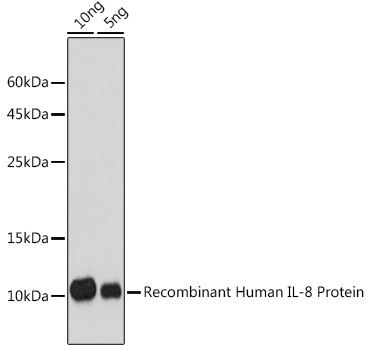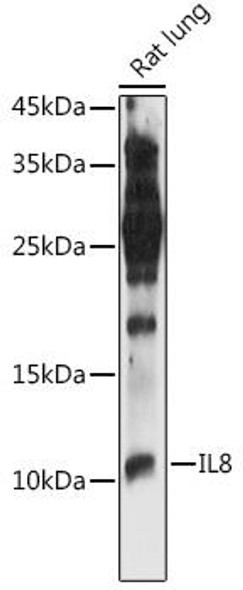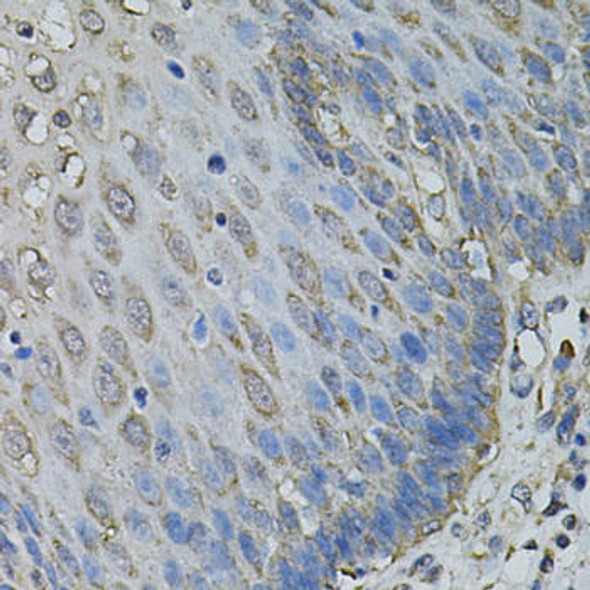Anti-IL-8 Antibody (CAB12452)
- SKU:
- CAB12452
- Product type:
- Antibody
- Reactivity:
- Human
- Host Species:
- Rabbit
- Isotype:
- IgG
- Antibody Type:
- Polyclonal Antibody
- Research Area:
- Cell Biology
Description
| Antibody Name: | IL8 Rabbit Polyclonal Antibody |
| Antibody SKU: | CAB12452 |
| Antibody Size: | 20uL, 50uL, 100uL |
| Application: | WB |
| Reactivity: | Human |
| Host Species: | Rabbit |
| Immunogen: | A synthetic peptide corresponding to a sequence within amino acids 1-99 of human IL8 (NP_000575.1). |
| Application: | WB |
| Recommended Dilution: | WB 1:500 - 1:2000 |
| Reactivity: | Human |
| Positive Samples: | Recombinant Human IL-8 Protein |
| Immunogen: | A synthetic peptide corresponding to a sequence within amino acids 1-99 of human IL8 (NP_000575.1). |
| Purification Method: | Affinity purification |
| Storage Buffer: | Store at -20°C. Avoid freeze / thaw cycles. Buffer: PBS with 0.02% sodium azide, 50% glycerol, pH7.3. |
| Isotype: | IgG |
| Sequence: | MTSK LAVA LLAA FLIS AALC EGAV LPRS AKEL RCQC IKTY SKPF HPKF IKEL RVIE SGPH CANT EIIV KLSD GREL CLDP KENW VQRV VEKF LKRA ENS |
| Gene ID: | 3576 |
| Uniprot: | P10145 |
| Cellular Location: | Secreted |
| Calculated MW: | 11kDa |
| Observed MW: | 10KDa |
| Synonyms: | CXCL8, GCP-1, GCP1, IL8, LECT, LUCT, LYNAP, MDNCF, MONAP, NAF, NAP-1, NAP1 |
| Background: | The protein encoded by this gene is a member of the CXC chemokine family. This chemokine is one of the major mediators of the inflammatory response. This chemokine is secreted by several cell types. It functions as a chemoattractant, and is also a potent angiogenic factor. This gene is believed to play a role in the pathogenesis of bronchiolitis, a common respiratory tract disease caused by viral infection. This gene and other ten members of the CXC chemokine gene family form a chemokine gene cluster in a region mapped to chromosome 4q. |
| UniProt Protein Function: | IL8: IL-8 is a chemotactic factor that attracts neutrophils, basophils, and T-cells, but not monocytes. It is also involved in neutrophil activation. It is released from several cell types in response to an inflammatory stimulus. IL-8(6-77) has a 5-10-fold higher activity on neutrophil activation, IL-8(5-77) has increased activity on neutrophil activation and IL-8(7-77) has a higher affinity to receptors CXCR1 and CXCR2 as compared to IL-8(1-77), respectively. Belongs to the intercrine alpha (chemokine CxC) family. 2 isoforms of the human protein are produced by alternative splicing. |
| UniProt Protein Details: | Protein type:Secreted, signal peptide; Cytokine; Secreted; Motility/polarity/chemotaxis Chromosomal Location of Human Ortholog: 4q13-q21 Cellular Component: extracellular space; extracellular region Molecular Function:protein binding; chemokine activity; interleukin-8 receptor binding Biological Process: regulation of cell adhesion; neutrophil chemotaxis; neutrophil activation; negative regulation of G-protein coupled receptor protein signaling pathway; unfolded protein response; calcium-mediated signaling; chemotaxis; signal transduction; regulation of retroviral genome replication; induction of positive chemotaxis; G-protein coupled receptor protein signaling pathway; negative regulation of cell proliferation; cellular protein metabolic process; unfolded protein response, activation of signaling protein activity; response to molecule of bacterial origin; receptor internalization; immune response; angiogenesis; cell cycle arrest; cell motility; inflammatory response; embryonic gut development |
| NCBI Summary: | The protein encoded by this gene is a member of the CXC chemokine family. This chemokine is one of the major mediators of the inflammatory response. This chemokine is secreted by several cell types. It functions as a chemoattractant, and is also a potent angiogenic factor. This gene is believed to play a role in the pathogenesis of bronchiolitis, a common respiratory tract disease caused by viral infection. This gene and other ten members of the CXC chemokine gene family form a chemokine gene cluster in a region mapped to chromosome 4q. [provided by RefSeq, Jul 2008] |
| UniProt Code: | P10145 |
| NCBI GenInfo Identifier: | 124359 |
| NCBI Gene ID: | 3576 |
| NCBI Accession: | P10145.1 |
| UniProt Secondary Accession: | P10145,Q6FGF6, Q6LAE6, Q96RG6, Q9C077, Q9UCE1, Q9UCR8 Q9UCR9, Q9UCS0, B2R4L8, |
| UniProt Related Accession: | P10145 |
| Molecular Weight: | 11,338 Da |
| NCBI Full Name: | Interleukin-8 |
| NCBI Synonym Full Names: | chemokine (C-X-C motif) ligand 8 |
| NCBI Official Symbol: | CXCL8 |
| NCBI Official Synonym Symbols: | IL8; NAF; GCP1; LECT; LUCT; NAP1; GCP-1; LYNAP; MDNCF; MONAP; NAP-1 |
| NCBI Protein Information: | interleukin-8; emoctakin; interleukin 8; T-cell chemotactic factor; neutrophil-activating peptide 1; beta-thromboglobulin-like protein; granulocyte chemotactic protein 1; tumor necrosis factor-induced gene 1; alveolar macrophage chemotactic factor I; monocyte-derived neutrophil chemotactic factor; monocyte-derived neutrophil-activating peptide; small inducible cytokine subfamily B, member 8; lymphocyte derived neutrophil activating peptide; lung giant cell carcinoma-derived chemotactic protein; beta endothelial cell-derived neutrophil activating peptide |
| UniProt Protein Name: | Interleukin-8 |
| UniProt Synonym Protein Names: | C-X-C motif chemokine 8; Chemokine (C-X-C motif) ligand 8; Emoctakin; Granulocyte chemotactic protein 1; GCP-1; Monocyte-derived neutrophil chemotactic factor; MDNCF; Monocyte-derived neutrophil-activating peptide; MONAP; Neutrophil-activating protein 1; NAP-1; Protein 3-10C; T-cell chemotactic factorCleaved into the following 7 chains:MDNCF-aAlternative name(s):GCP/IL-8 protein IV; IL8/NAP1 form I |
| UniProt Gene Name: | CXCL8 |
| UniProt Entry Name: | IL8_HUMAN |









